Design of an Adaptive Height Control System for Sugarcane Harvester Header
Abstract
:1. Introduction
2. Materials and Methods
2.1. Overall System Structure
2.2. Design of Sugarcane Cutting Test Bench
2.3. Ground Height Detection
2.3.1. Data Acquisition
2.3.2. Terrain Inversion
2.3.3. Identification of Sugarcane Growth Point Height
2.4. Control System Design
2.4.1. I/O Port Allocation
2.4.2. Data Acquisition and Processing
2.4.3. Design of Cutting Header Height Control Logic
2.4.4. Target Height Error Range Program
2.4.5. Cutting Height Adaptive Control Process
3. Results and Discussion
3.1. Ground Height Acquisition with LiDAR
3.2. Control Accuracy
3.3. Discussion
4. Conclusions
Author Contributions
Funding
Data Availability Statement
Conflicts of Interest
References
- López-Ortega, M.G.; Guadalajara, Y.; Junqueira, T.L.; Sampaio, I.L.; Bonomi, A.; Sánchez, A. Sustainability analysis of bioethanol production in Mexico by a retrofitted sugarcane industry based on the Brazilian expertise. Energy 2021, 232, 121056. [Google Scholar] [CrossRef]
- Omprakash, S. Assessment of sugarcane industry: Suitability for production, consumption, and utilization. Ann. Agrar. Sci. 2018, 16, 389–395. [Google Scholar]
- Wang, Z. Mechanism Research and Design Simulation of Soil Cutting Control for Sugarcane Harvesters. Master’s Thesis, Guangxi University, Nanning, China, 2014. [Google Scholar]
- Bai, J.; Ma, S.; Yang, G.; Wang, F.; Xing, H.; Ke, W. Testing and Analysis of the Extractor of a Sugarcane Chopper Harvester. Trans. ASABE 2020, 63, 251–257. [Google Scholar] [CrossRef]
- Ding, Z.; Ma, S.; Wang, F.; Xing, H.; Bai, J.; Hu, J. Development and Testing of an Electro-Hydraulic System for Height Control of Sugarcane Harvester Basecutter. J. ASABE 2022, 65, 305–312. [Google Scholar] [CrossRef]
- Mantovani, E.C.; Oliveira, P.E.B.; Queiroz, D.M.; Fernandes, A.L.T.; Cruvinel, P.E. Current status and future prospect of theagricultural mechanizationin Brazil. Agric. Mech. Asia Afr. Lat. Am. 2019, 50, 20–22. [Google Scholar]
- Zhao, L.; Zhang, J.; Jiao, S.; Zheng, T.; Li, J.; Zhao, T. Ground surface detection method using ground penetrating radar signal for sugarcane harvester base-cutter control. Biosyst. Eng. 2022, 219, 103–123. [Google Scholar] [CrossRef]
- Jian, Z.; Li, G.; Zhao, S.; Ma, C. Simulated experimental study on the automatic adjustment system of sugarcane harvester header height. J. Southwest Univ. (Nat. Sci. Ed.) 2018, 40, 12–18. [Google Scholar]
- Liao, Y.; Xiang, Y.; Wu, M.; Liu, D.; Chen, Y.; Li, Y. Design and testing of an adaptive height adjustment system for combine harvesters. J. Hunan Agric. Univ. 2018, 44, 326–329. [Google Scholar]
- Zhang, C. Research on Crop Height Measurement Method and Crop Profile Modeling of Harvester Cutting Platform. Master’s Thesis, Southeast University, Nanjing, China, 2019. [Google Scholar]
- Ni, Y.; Jin, C.; Chen, M.; Yuan, W.; Qian, Z.; Yang, T.; Cai, Z. Computational model and adjustment system of header height of soybean harvesters based on soil-machine system. Comput. Electron. Agric. 2021, 183, 105907. [Google Scholar] [CrossRef]
- Wen, J.; Yin, Y.; Zhang, Y.; Pan, Z.; Fan, Y. Detection of Wheat Lodging by Binocular Cameras during Harvesting Operation. Agriculture 2023, 13, 120. [Google Scholar] [CrossRef]
- Hu, X.; Wei, X.; Sun, J. A Noising-Denoising Framework for Point Cloud Upsampling via Normalizing Flows. Pattern Recognit. 2023, 140, 109569. [Google Scholar] [CrossRef]
- Wen, G.; Zhang, H.; Guan, Z.; Wei, S.; Jia, D. Bilateral filter denoising of Lidar point cloud data in automatic driving scene. Infrared Phys. Technol. 2023, 131, 104724. [Google Scholar]
- Deng, S.; Xu, Q.; Yue, Y.; Jing, S.; Wang, Y. Individual tree detection and segmentation from unmanned aerial vehicle-LiDAR data based on a trunk point distribution indicator. Comput. Electron. Agric. 2024, 218, 108717. [Google Scholar] [CrossRef]
- Chen, M.; Zhai, X.; Zhang, H.; Yang, R.; Wang, D.; Shang, S. Study on control strategy of the vine clamping conveying system in the peanut combine harvester. Comput. Electron. Agric. 2020, 178, 105744. [Google Scholar] [CrossRef]
- Chen, L.; Guo, Y. Design of the Distributed Control System Based on CAN Bus. Comput. Inf. Sci. 2011, 4, 83. [Google Scholar] [CrossRef]
- Zeng, L.; Du, H.; Ye, X.; Huang, J.; Chen, C.; Chen, X.; Ding, J. Research and experiments on low throttle loss switched inertance hydraulic systems based on inertive elements. Energy 2023, 283, 129073. [Google Scholar] [CrossRef]
- Robles-Durazno, A.; Moradpoor, N.; McWhinnie, J.; Russell, G.; Maneru-Marin, I. PLC memory attack detection and response in a clean water supply system. Int. J. Crit. Infrastruct. Prot. 2019, 26, 100300. [Google Scholar] [CrossRef]
- Gong, Y.; Jin, Z.; Bai, X.; Wang, S.; Wu, L.; Huang, W. Design and Experiment of the Cutter Bar Follow-up Control System for Sugarcane Harvester. J. Agric. Mach. 2023, 54, 119–128. [Google Scholar]
- Borase, R.P.; Maghade, D.K.; Sondkar, S.Y.; Pawar, S.N. A review of PID control, tuning methods and applications. Int. J. Dyn. Control 2021, 9, 818–827. [Google Scholar] [CrossRef]
- Jin, Z.; Gong, M.; Zhao, D.; Zhang, Y.; Liu, W.; Zhu, J.; Su, B. MPC motion control of boom descending of unmanned excavator based on regenerative valve. Heliyon 2024, 10, e29915. [Google Scholar] [CrossRef] [PubMed]






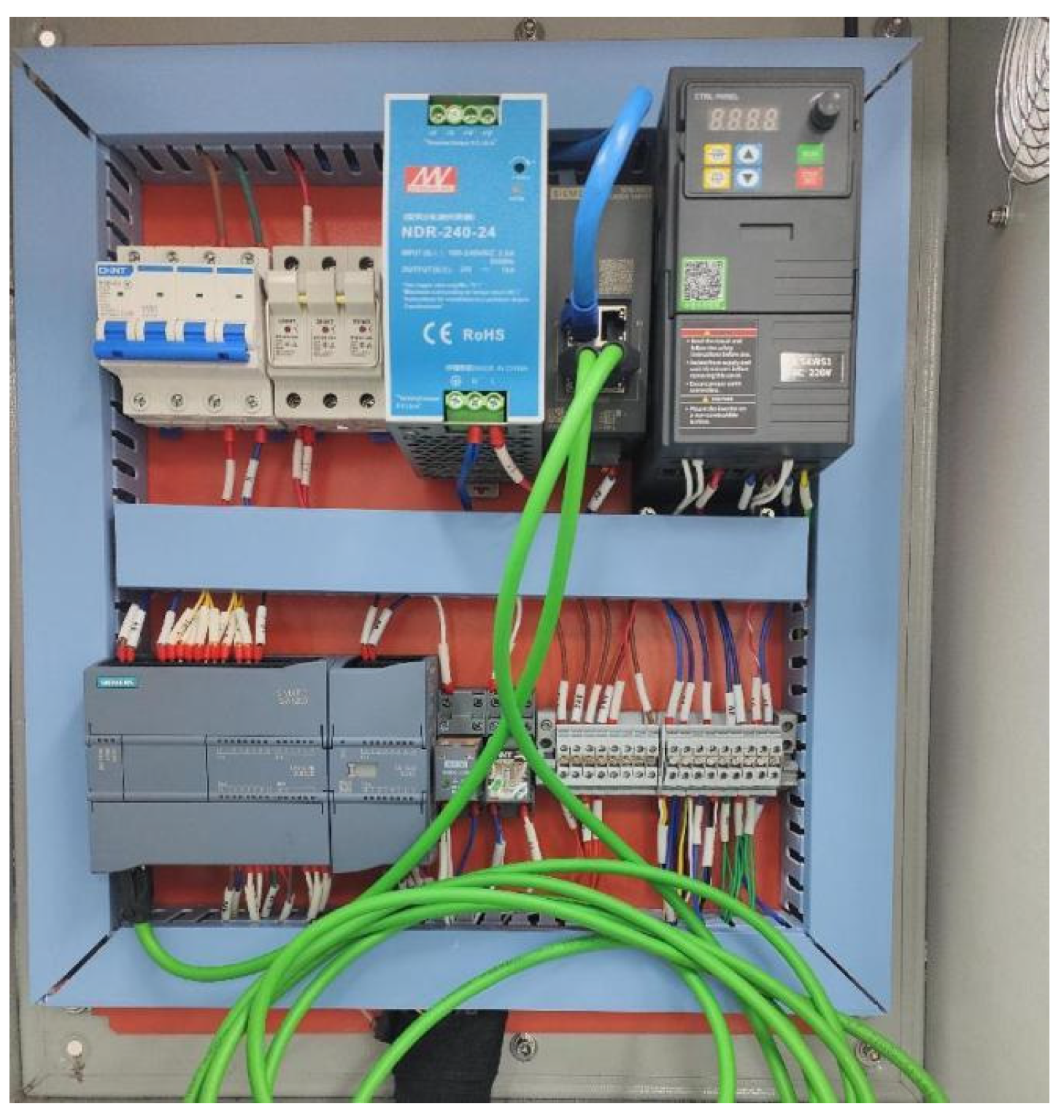
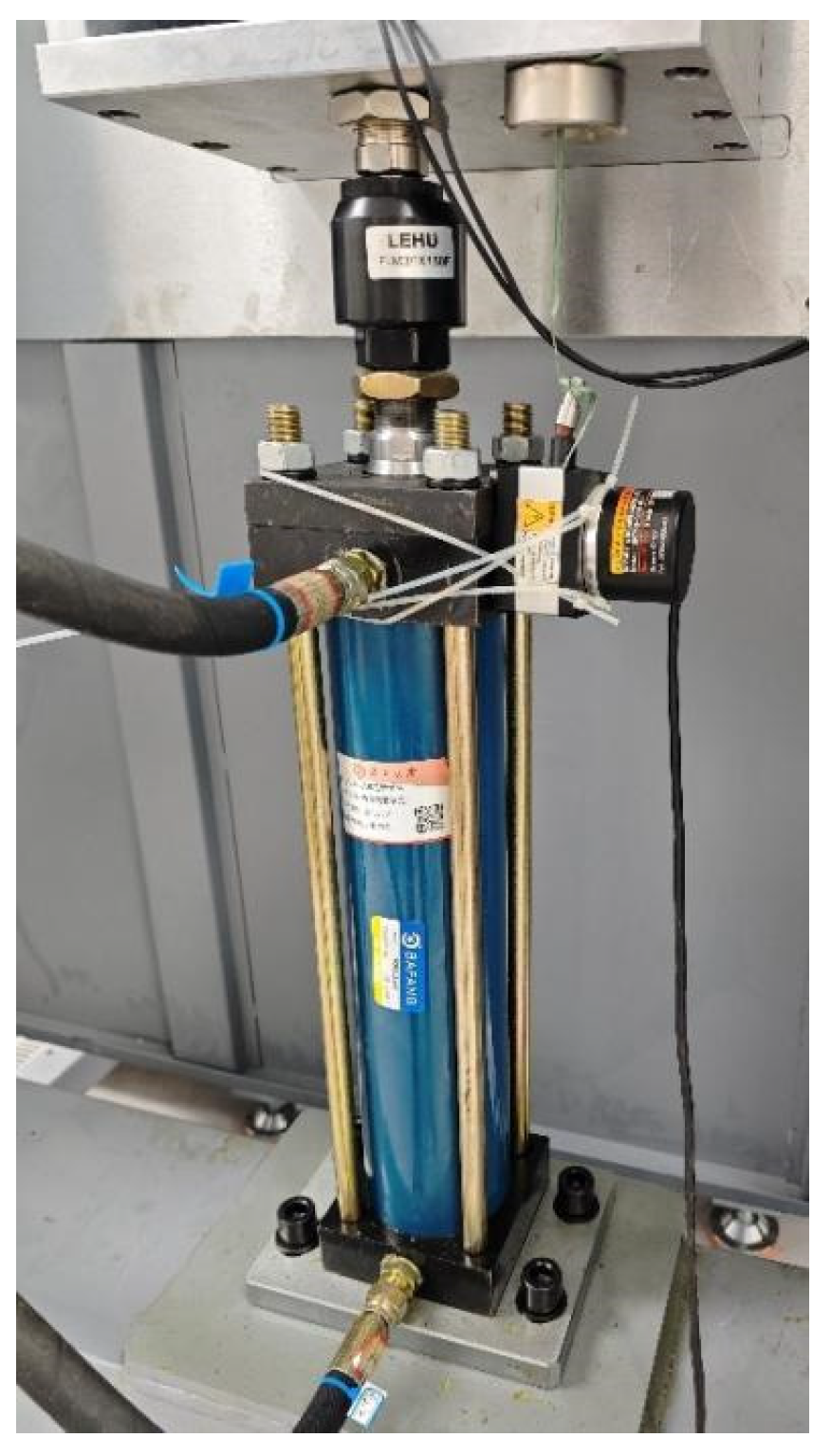
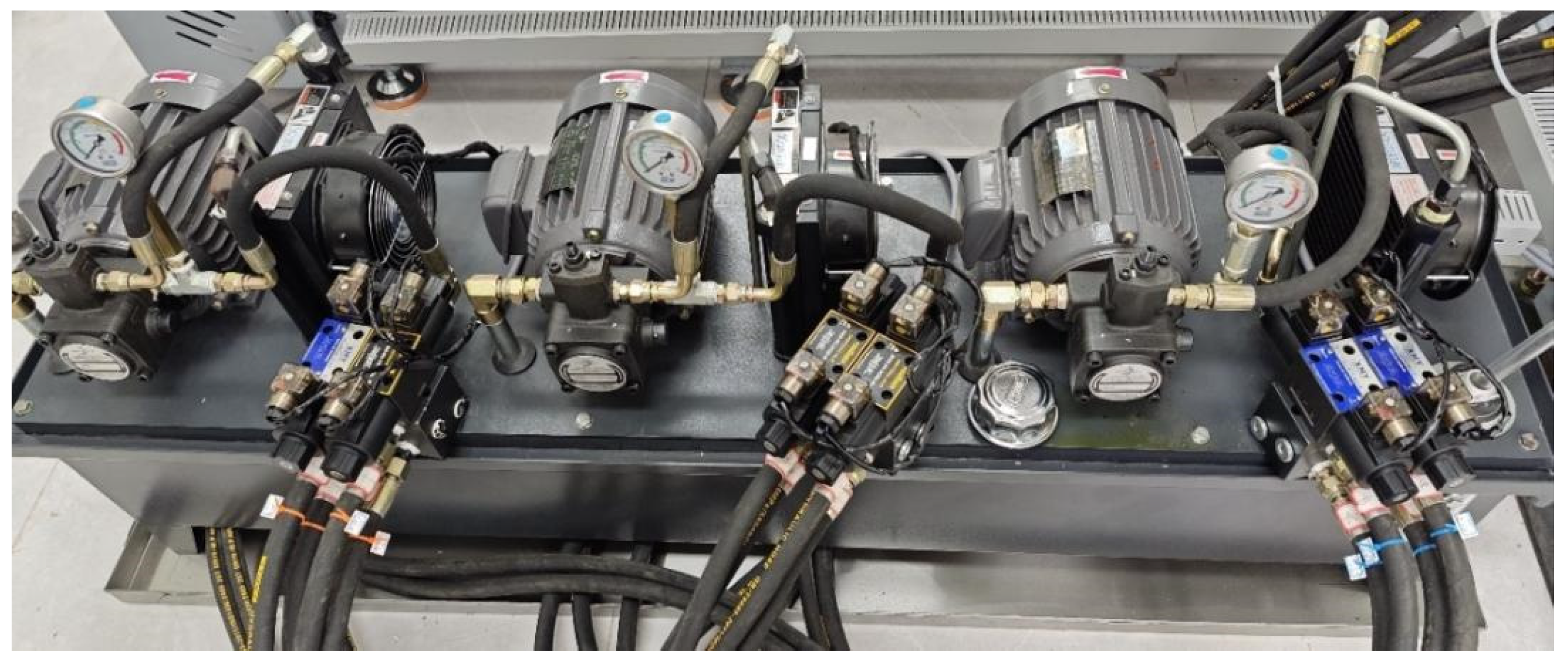
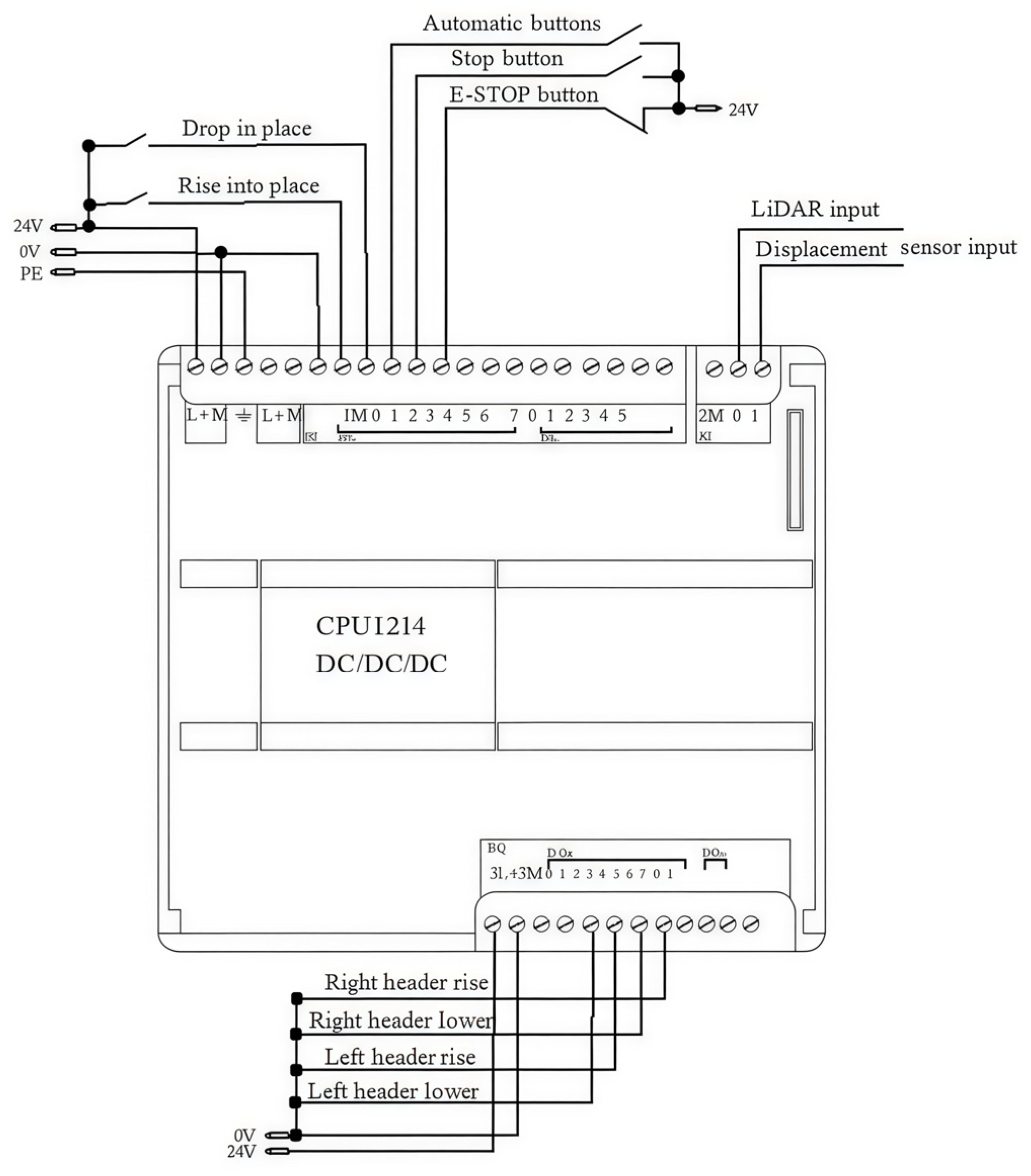

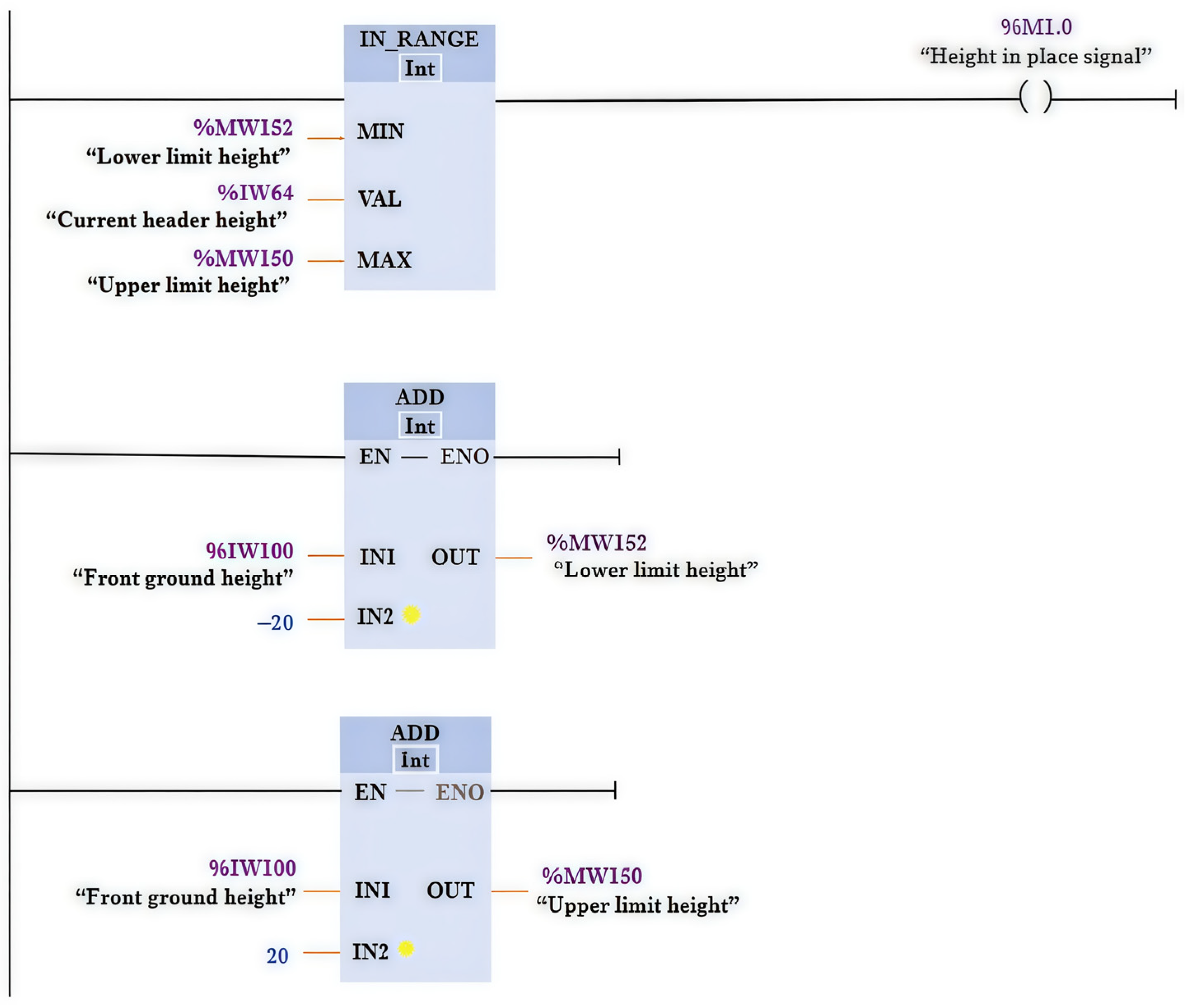
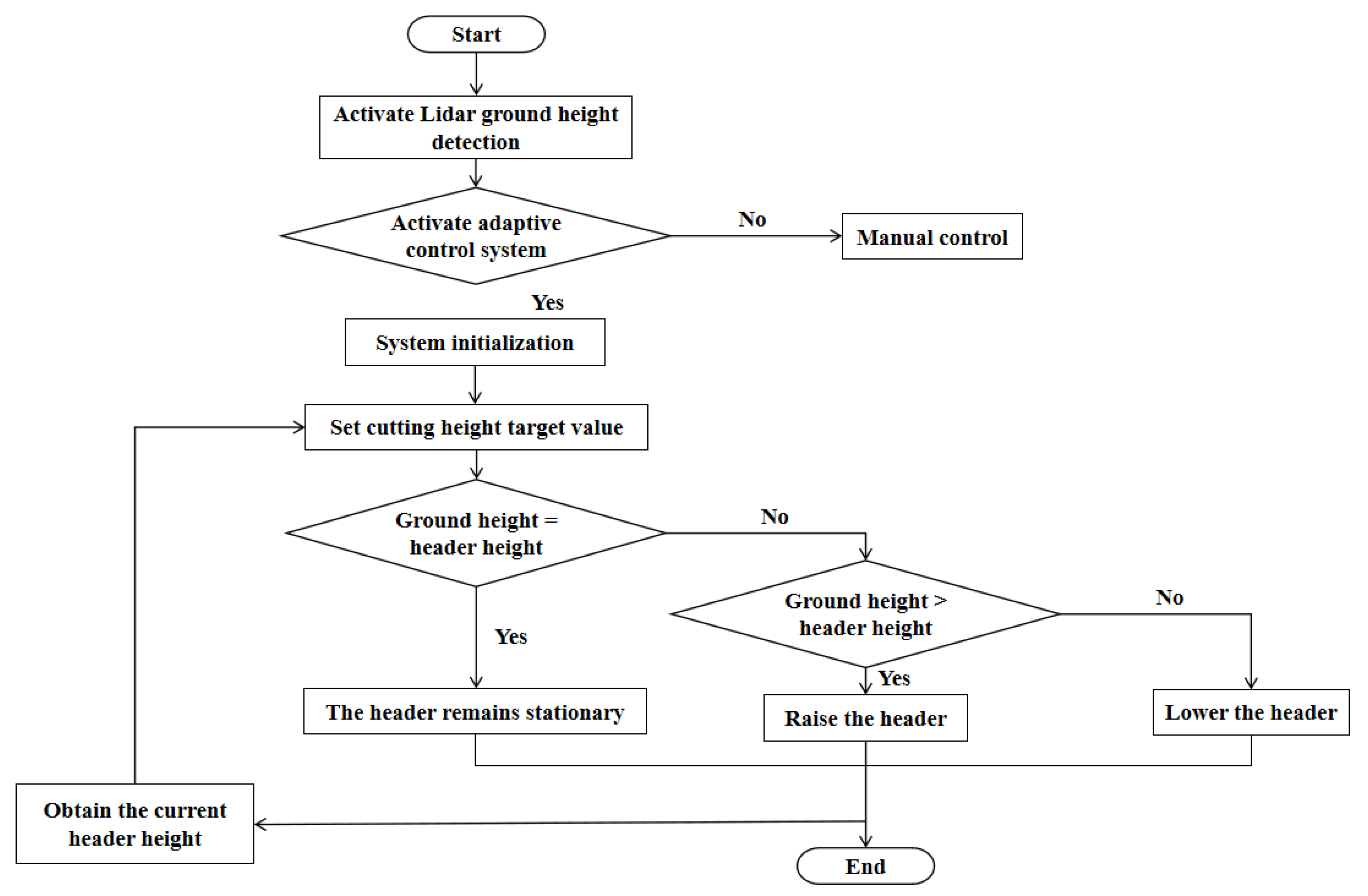



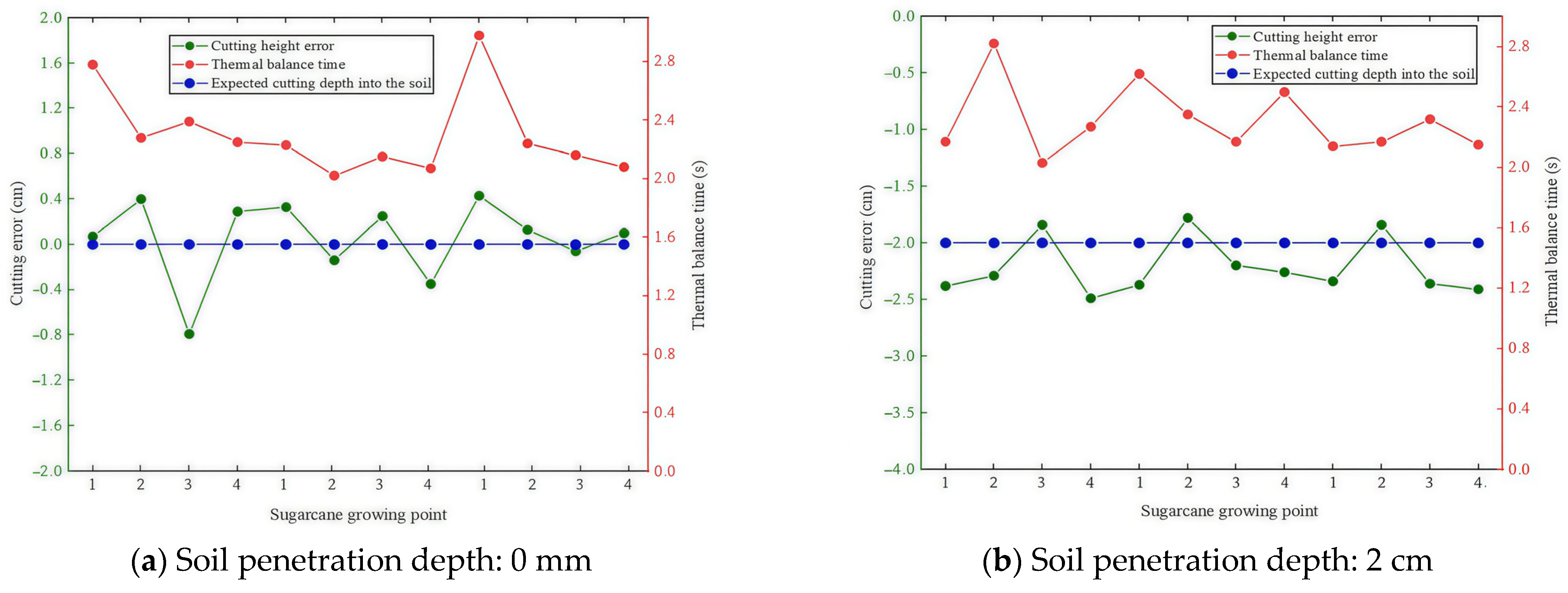
| Components | Parameters |
|---|---|
| Gantry main frame | Overall dimensions: length 7.5 m, width 1.5 m |
| Load: 1200 kg | |
| Material: carbon steel Q235A | |
| Lifting device | Maximum load: 2000 kg |
| Cylinder diameter: 80 mm | |
| Maximum stroke: 300 mm | |
| Tilting mechanism | Tilt angle: −15°~+15° |
| Hydraulic system | Hydraulic system flow rate: 120 L/min |
| Hydraulic pump motor power: 25 kw | |
| Speed: 1200 r/min | |
| Chain conveyor line | Length: 6 m |
| Motor power: 1.5 kw | |
| Conveying speed: maximum 1.38 m/s | |
| Sugarcane fixing fixture | Clamping force: 850 N |
| Clamp sleeve diameter: 20~50 mm | |
| Plant spacing: 150~300 mm |
| I/O Type | Port | Connected Device | Description |
|---|---|---|---|
| DI | I0.0 | Lifting hydraulic cylinder | Control the rise manually into position |
| DI | I0.1 | Lifting hydraulic cylinder | Control the drop manually into position |
| DQ | Q0.0 | Left header hydraulic valve | Control the left header’s upward movement |
| DQ | Q0.1 | Left header hydraulic valve | Control the left header’s downward movement |
| DQ | Q0.2 | Right header hydraulic valve | Control the right header’s upward movement |
| DQ | Q0.3 | Right header hydraulic valve | Control the right header’s downward movement |
| AI | IW64 | Draw-wire displacement sensor | Receive analog signals of the header height |
| AI | IW100 | LiDAR | Receive analog signals of the terrain height |
| Obstruction Condition | Measurement Point | Cutting Depth into Soil (cm) | Actual Ground Height (cm) | Cutting Height (cm) | Time to Reach Steady State (s) | Deviation (cm) |
|---|---|---|---|---|---|---|
| No obstruction | 1 | 0 | 70.95 | 71.02 | 2.78 | 0.07 |
| 2 | 0 | 77.46 | 77.86 | 2.28 | 0.4 | |
| 3 | 0 | 70.92 | 70.13 | 2.39 | −0.79 | |
| 4 | 0 | 73.50 | 73.79 | 2.25 | 0.29 | |
| Obstructed by weeds | 1 | 0 | 70.51 | 70.84 | 2.23 | 0.33 |
| 2 | 0 | 73.76 | 73.62 | 2.02 | −0.14 | |
| 3 | 0 | 75.30 | 75.55 | 2.15 | 0.25 | |
| 4 | 0 | 77.39 | 77.04 | 2.07 | −0.35 | |
| Obstructed by weeds and sugarcane leaves | 1 | 0 | 77.16 | 77.59 | 2.98 | 0.43 |
| 2 | 0 | 72.33 | 72.46 | 2.24 | 0.13 | |
| 3 | 0 | 69.85 | 69.79 | 2.16 | −0.06 | |
| 4 | 0 | 74.63 | 74.73 | 2.08 | 0.1 |
| Obstruction Condition | Measurement Point | Cutting Depth into Soil (cm) | Actual Ground Height (cm) | Cutting Height (cm) | Time to Reach Steady State (s) | Deviation (cm) |
|---|---|---|---|---|---|---|
| No obstruction | 1 | −2 | 68.32 | 65.94 | 2.17 | −2.38 |
| 2 | −2 | 76.84 | 74.55 | 2.82 | −2.29 | |
| 3 | −2 | 71.25 | 69.41 | 2.03 | −1.84 | |
| 4 | −2 | 78.63 | 76.14 | 2.27 | −2.49 | |
| Obstructed by weeds | 1 | −2 | 75.72 | 73.35 | 2.62 | −2.37 |
| 2 | −2 | 68.57 | 66.79 | 2.35 | −1.78 | |
| 3 | −2 | 78.28 | 76.08 | 2.17 | −2.20 | |
| 4 | −2 | 73.15 | 70.89 | 2.50 | −2.26 | |
| Obstructed by weeds and sugarcane leaves | 1 | −2 | 76.81 | 74.47 | 2.14 | −2.34 |
| 2 | −2 | 70.36 | 68.52 | 2.17 | −1.84 | |
| 3 | −2 | 78.28 | 75.92 | 2.32 | −2.36 | |
| 4 | −2 | 73.64 | 71.23 | 2.15 | −2.41 |
Disclaimer/Publisher’s Note: The statements, opinions and data contained in all publications are solely those of the individual author(s) and contributor(s) and not of MDPI and/or the editor(s). MDPI and/or the editor(s) disclaim responsibility for any injury to people or property resulting from any ideas, methods, instructions or products referred to in the content. |
© 2024 by the authors. Licensee MDPI, Basel, Switzerland. This article is an open access article distributed under the terms and conditions of the Creative Commons Attribution (CC BY) license (https://creativecommons.org/licenses/by/4.0/).
Share and Cite
Shi, M.; Li, Y.; Pan, Y.; Lu, L.; Wei, J. Design of an Adaptive Height Control System for Sugarcane Harvester Header. Agronomy 2024, 14, 1644. https://doi.org/10.3390/agronomy14081644
Shi M, Li Y, Pan Y, Lu L, Wei J. Design of an Adaptive Height Control System for Sugarcane Harvester Header. Agronomy. 2024; 14(8):1644. https://doi.org/10.3390/agronomy14081644
Chicago/Turabian StyleShi, Meiqi, Yanzhou Li, Yingchun Pan, Linfei Lu, and Jin Wei. 2024. "Design of an Adaptive Height Control System for Sugarcane Harvester Header" Agronomy 14, no. 8: 1644. https://doi.org/10.3390/agronomy14081644




